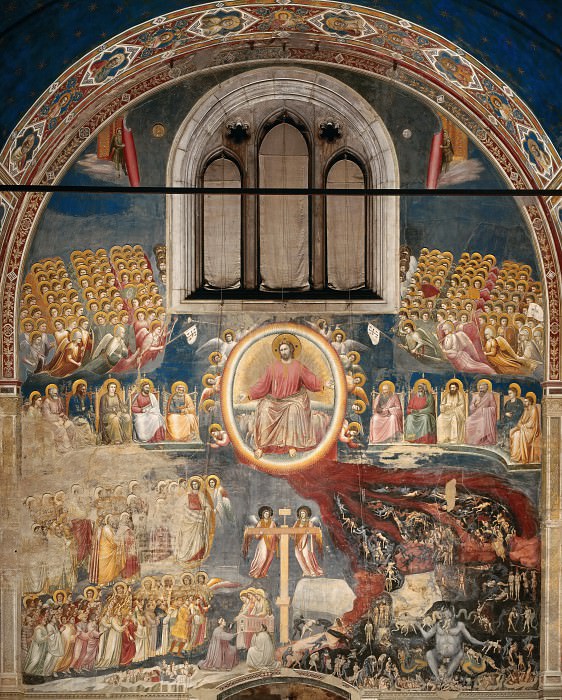54 Last Judgment Giotto di Bondone (1266-1337)
Giotto di Bondone – 54 Last Judgment
Edit attribution
Download full size: 4616×5757 px (13,2 Mb)
Painter: Giotto di Bondone
The "Last Judgment" fresco by the great Renaissance representative Giotto, has been adorning the walls of a small church in Padua for over 500 years. It was thanks to Giotto that the church, or the Chapel of the Bloodshed, became world-famous, and has become a place of pilgrimage for thousands of tourists. This extensive depiction of the Last Judgment, which is located on the west side of the church, is dominated by a large Jesus Christ, towering majestically in the center.
Description of Giotto Di Bondone’s "The Last Judgment" cartoon
The "Last Judgment" fresco by the great Renaissance representative Giotto, has been adorning the walls of a small church in Padua for over 500 years. It was thanks to Giotto that the church, or the Chapel of the Bloodshed, became world-famous, and has become a place of pilgrimage for thousands of tourists.
This extensive depiction of the Last Judgment, which is located on the west side of the church, is dominated by a large Jesus Christ, towering majestically in the center. To his left and right sit the twelve apostles. In the middle are the Archangels Michael and Raphael holding the cross. The fresco can be divided into two levels: above there is the heavenly host, below the people are plunged into the jaws of hell, or moved towards heaven, guided by angels.
Christ is on the throne as the supreme judge. The deep shining gold background, the subtle style of the painting give the impression that the heavens have opened to reveal the powerful, extremely clearly modeled figure of Christ. At various levels of the fresco, one sees a choir of angels disappearing behind a real window or the golden-red doors of the heavenly Jerusalem shining at the top of the painting. In stark contrast to the heavens is the black and red maw of hell, which may have foreshadowed Dante’s Inferno.
Giotto ingeniously makes the connection between today’s world of believers and the canonical world that existed throughout creation-the Last Judgment. An interesting detail is the depiction of Enrico Scroveni, who ordered the building of the church. His kneeling figure is located at the bottom of the fresco. In this way, he was atoning for the sins of his moneylender father, because back then moneylending was equal to mortal sins.
Кому понравилось
Пожалуйста, подождите
На эту операцию может потребоваться несколько секунд.
Информация появится в новом окне,
если открытие новых окон не запрещено в настройках вашего браузера.
You need to login
Для работы с коллекциями – пожалуйста, войдите в аккаунт (open in new window).




















You cannot comment Why?
At the apex of the scene, within a simulated architectural window, lies an expanse of deep blue sky, punctuated by ornate decorative borders. This upper register is populated by numerous figures – likely blessed souls – arranged in dense ranks, their faces exhibiting expressions of serenity and reverence. They appear to be ascending towards a central figure, bathed in radiant light.
This central figure dominates the composition; he is encircled by a halo and appears to preside over the unfolding events below. His posture conveys authority and solemnity. Surrounding him are additional angelic figures, some with wings spread wide, suggesting movement and divine power.
The lower portion of the fresco is characterized by dramatic contrasts in color and emotional intensity. A vast throng of humanity is depicted, divided into two distinct groups. On the left, individuals appear to be being led towards salvation, their gestures conveying supplication and hope. They are guided by figures carrying a cross – a potent symbol of sacrifice and redemption.
In stark contrast, the right side portrays a chaotic scene of torment and despair. Figures are shown being dragged down into a fiery abyss, their faces contorted in anguish. Grotesque demonic entities populate this lower realm, adding to the sense of dread and eternal punishment. The use of deep reds and browns intensifies the visual impact of this area, creating a palpable atmosphere of suffering.
The artist employed a hierarchical scale throughout the work, emphasizing the importance of the central figure and the distinction between the saved and the damned. The meticulous detail in rendering individual faces and garments suggests an intention to convey both the grandeur of divine judgment and the personal consequences for each soul.
Subtly, the architectural framework – the simulated window – creates a sense of depth and perspective, drawing the viewers eye into the scene. This technique also serves to integrate the fresco within the larger context of the building’s architecture, blurring the boundaries between painted illusion and physical space. The overall effect is one of overwhelming power and profound spiritual significance.